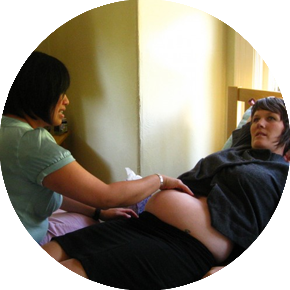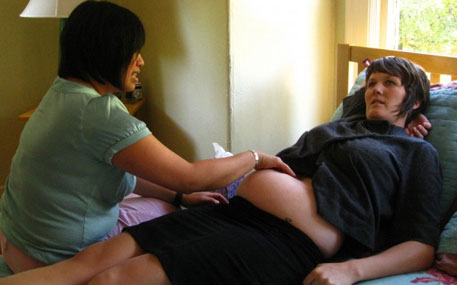Why the witch hunt of midwives is alive and well in 2016

 The latest attack on Australian midwives has come from Australian Medical Association Queensland president Chris Zappala who stated in a media release this week that research showed perinatal death rates doubled when women gave birth under midwife-led care compared to when treated by an obstetrician.
The latest attack on Australian midwives has come from Australian Medical Association Queensland president Chris Zappala who stated in a media release this week that research showed perinatal death rates doubled when women gave birth under midwife-led care compared to when treated by an obstetrician.
In a report just published by AMA Queensland, the authors state, "The current public hospital maternity services model could best be described as midwife-led with obstetrician rescue."
All this makes for terrific news fodder, with Ten News Queensland jumping on the story with this alarmist report which aired on October 12.
Undermining midwifery-led care and pitting it against obstetric-led care is nothing new. From the dawn of time, women have been cared for by other women during childbirth and this was the dominant model of care until the mid-19th Century when the medical profession, and in particular, obstetrics, started to become professionalised. To understand how we got to where we are today, it is essential to understand the socio-historical medical domination and the subsequent virtual obliteration of midwifery as an independent discipline.
In Kathleen Fahy's fascinating 2007 paper; An Australian history of the subordination of midwifery, we learn how the profession of medicine interplayed with the tradition of midwifery dating back as far as the 1700s.
In the early 1800s, Australia received an influx of unemployed GPs from Great Britain. It is important to remember that, at this time, GPs were not required to have a university education. Medicine as a discipline was in a pre-scientific era because the causes of most diseases were unknown, medical treatments were based on unproven theories and were not very effective.
With the help of the Australian government, GP's were able to establish themselves as a profession. This meant they were registered with the government and could exercise autonomy over their own practice. Being registered with the government meant that doctors had a monopoly over 'medical practice' and this gave doctors a legitimacy which led to increases in income and social class.
In contrast to the social climbing, middle class doctors, Australian midwives at the time were largely uneducated and overwhelmingly working class. In addition to the clear socio-economic divide, it can be convincingly argued that the takeover of midwifery by medicine was an example of gender-based oppression; an oppression from which women and midwives are still suffering today.
In order for doctors to lure women away from traditional midwife-led care and justify their necessity for all labours (not just the complicated ones), they needed to convince the masses that their health and their baby's health was at risk if they were being cared for by illiterate, unhygienic midwives. This really marked the introduction of routine obstetric intervention, and in particular the introduction of forceps, resulting in a proliferation of birth injuries to both mothers and infants at the time.
It wasn't until 1888 that the first course in midwifery was commenced at the Women's hospital in Melbourne, although it was heavily criticised by both nurses and doctors, who didn't support what was essentially Australia's first direct-entry midwifery training program.
Even today, almost 130 years later, support for medicine, is expressed through state-initiated law, policy and actions. An example of a law that protects and supports medical interest is that Medicare rebates are essentially limited to medical treatments, which excludes a number of midwifery services, including claiming for private midwifery care for a home birth. An example of a government policy was when the Federal government decided in 2004 to provide support for medical indemnity insurance for birth whilst refusing to do the same for midwives. This explains why, for example, in Victoria today there are a handful of independent midwives in private practice and literally hundreds of obstetricians.
In 2014, highly respected UK medical journal, The Lancet published an entire Series devoted to midwifery. According to the journal;
"Midwifery is a vital solution to the challenges of providing high-quality maternal and newborn care for all women and newborn infants, in all countries."
Key findings demonstrated that outcomes improved by midwifery care include reduced maternal and newborn mortality, reduced stillbirth, reduced perineal trauma, reduced instrumental birth, reduced intrapartum analgesia or anaesthesia, less severe blood loss, fewer preterm births, fewer newborn infants with a low birth weight, and less hypothermia. The analyses also found increased spontaneous onset of labour, greater numbers of unassisted vaginal births, and increased rates of initiation and duration of breastfeeding. Increased referrals for pregnancy complications, fewer admissions to neonatal intensive care units, and shorter stays in neonatal units are examples of outcomes that indicate both improved care and resource use. Importantly, women reported a higher rate of satisfaction with care in general and with pain relief in labour in particular, and improved mother-baby interaction was also identified.
The key messages that we can take from this ground-breaking series are as follows;
Women desire respectful, clinically competent care. They value good communication, high-quality information, having a sense of control, and the ability to participate in their care and make choices. They want trusting relationships with care providers who are sensitive to their personal and cultural needs. In a nutshell – this is very definition of midwifery-led care.
The Series also highlighted the importance of supporting normal, physiological labour and birth (again – a central tenet of midwifery-led care).
"Care that promotes, supports, and protects innate, hormonally driven, physiological processes optimises labour, birth, breastfeeding, and attachment, assisting women and newborn infants during these immense perinatal life transitions, whereas medical interventions often disrupt these processes."
The concluding paragraphs in The Lancet's series are frighteningly prescient in light of the AMA Queensland president's recent statements;
"Some high-income countries disproportionately influence global maternity-care practice and systems. The influence occurs through training of health personnel, journals, research programmes, and medical industries that promote profitable products. Much of the effect is positive, but overuse of a medicalised approach and undermining of midwifery are harmful.
They damage established midwifery systems and create barriers to development, restoration, and strengthening of quality midwifery care. For the sake of global maternal and newborn well-being, policy makers and funders must not overlook maternity care quality improvement in nations with outsized worldwide effect. Scaling up quality midwifery would greatly accelerate the present momentum for reaching maternal and child health goals. Rapid gains in care, health, and value for investment are within reach."
Every leading international healthcare organisation has concluded that midwife-led care is the gold standard of maternity care for all women, even those labelled as being "high risk".
If we are to believe the results of the research conducted by the AMA, then astonishingly their evidence flat out contradicts the international recommendations and guidelines as set out by the World Health Organisation (WHO) and National Institute for Health and Care Excellence (NICE).
Let's be totally honest for a minute shall we? This has nothing to do with prioritising the health and wellbeing of Australian women and their babies and everything to do with preserving and protecting the earning potential of obstetricians and the age-old delegitimization of midwives.
Tanya Strusberg is the founder of birthwell birthright. She is a Melbourne-based Lamaze Certified Childbirth Educator and a Fellow of the Association of Certified Childbirth Educators (FACCE). She is a passionate advocate for women's maternity care and her articles have appeared in The Journal of Perinatal Education, Australian Midwifery News, Science & Sensibility, Interaction – the journal of the Childbirth and Parenting Educators Association of Australia (CAPEA), Empowering Birth Magazine, Rockstar Birth Magazine, Mum's Lounge, Go Ask Mum and Whole Woman. Through her internationally-accredited Lamaze Educator Training program, she is very excited to be training a new generation of Australian Lamaze educators. Last, but absolutely not least, she is also the mum of two beautiful children, her son Liev and daughter Amalia.

